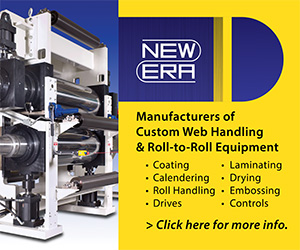Sticking With It | Q&A on Testing and Evaluation
- Published: August 08, 2017, By Ingrid Brase
Adhesive expert Ingrid Brase covers the key considerations you need to address when launching a new product.
 In several of my past columns, I have shared some thoughts on how to select the right pressure-sensitive adhesive (PSA) for different end-use markets. In each installment, I have spoken about the importance of testing and evaluation before launching a new product. Here we will focus on some details of that testing and evaluation.
In several of my past columns, I have shared some thoughts on how to select the right pressure-sensitive adhesive (PSA) for different end-use markets. In each installment, I have spoken about the importance of testing and evaluation before launching a new product. Here we will focus on some details of that testing and evaluation.
So let’s take a closer look at the testing and evaluation of PSA products by considering some key questions:
- How do I know my product will survive in the environment in which it will be used?
- Do I need to consider any special testing for regulatory certification?
- How do I know I am getting the same adhesive every time?
- How do I make sure my customer gets the same adhesive performance from my product each time?
During the development phase, we will need to do an evaluation of adhesive and product performance to aid in selection of the right components to meet our needs. The first two questions will need to be answered before we begin manufacturing our new product. The last two questions relate to on-going quality assurance once we have developed our new product and have successfully begun selling to our customers. So, let’s take each of these questions and delve into what types of testing might provide some answers.
During the development phase, evaluation of adhesive performance to determine adhesion and cohesive properties will be key. Data will be provided by the adhesive suppliers but additional testing utilizing the facestock and liners selected for the eventual product also will be important. If in-house resources are not available, adhesive suppliers may conduct some of the evaluations or contracting an outside laboratory can be considered. The amount of testing required will vary depending on the application as well as any regulatory requirements for certification.
Q. How do I know my product will survive in the environment in which it will be used?
As has been previously described, gaining an in depth understanding of how the customer will utilize a product will ensure being able to delight them. For properties like temperature, solvent exposure, humidity, etc., proper selection of the right PSA chemistry improves the chances of success. For instance, if a tape will be used to secure a component on a roof, survival at high and low temperatures will be needed, so most likely a solvent–based adhesive would be the best option. In many cases the environmental conditions that the product will need to survive can be reproduced in the lab using humidity chambers, ovens, etc.
Evaluation of the complete construction to determine how the adhesive ages on the liner and substrate is also important. As an example, vinyls or PVC used in labels or graphics all contain residuals that leech from the material over time. These components can have an adverse effect on the adhesive. Vinyl shrinks as it ages as well so the adhesive must be evaluated to determine if it has the strength to hold the construction in place.
Accelerated aging tests conducted in the lab are not a true substitute for real life aging but at least gives us a good indication of what to expect. Looking at how the components interact, i.e., conducting peel evaluations under controlled conditions, provides information on how the adhesive will release when peeled manually or by machine.
Q. Do I need to consider any special testing for regulatory certification?
Again, this is where dialog with the customer to understand how they plan to use the new product is key. If the end-use application will require certification, then this must be done before sale of the product begins. The certifying agencies will provide their requirements and should be consulted to ensure the right testing is done. In many cases, the adhesives suppliers will have useful background data available as well. For instance, if the application is for medical use, the adhesive manufacturer can provide skin sensitivity data per ISO protocols.
Q. How do I know I am getting the same adhesive every time?
As we have discussed in previous articles, adhesives are polymers or mixtures of polymers. To feel confident that we are getting the same product each time, we start by selecting a reliable supplier. When considering a supplier, look for someone with a track record of consistent production. Companies that are ISO certified and/or can provide data on their manufacturing reliability are good choices. Your adhesive supplier should be characterizing the adhesives they manufacture by the polymer or product properties, going above and beyond just adhesive performance. This testing can include evaluation of molecular weight for polymers like solvent-based acrylics, particle size for emulsions, softening points for hot melts, viscosity, pH, and residuals (i.e., monomers for emulsion and solvent-based acrylics).
Q. How do I make sure my customer gets the same adhesive performance from my product each time?
To address this question, we start with the adhesive supplier. In addition to the data they can provide characterizing the adhesive polymer or mixture, PSA manufacturers also will evaluate adhesive performance for each batch of product made. These can include basic performance like peel, tack, and shear. It should be noted that these tests will be done using a standard method, such as the Pressure Sensitive Tape Council (PSTC) or ASTM methods. As an example, for peel performance, the PSTC method calls for the adhesive to be coated to polyester and peeled at a 180-deg angle. The evaluation is done in a constant temperature/humidity chamber to ensure reproducibility. This data can be requested as part of the certificate of analysis for adhesive supplied.
While having data from the adhesive supplier is useful, it is also important to conduct in-house testing on each of the components of the construction. Determining a few simple tests to run on incoming materials is highly recommended. Doing a little testing up front can save both time, money, and potential customer dissatisfaction.
Mistakes happen. As an example, one customer complaint on adhesive performance turned out to be caused by under-cured liner; silicone transfer impacted the peel and shear performance of the adhesive. In another case, the wrong solvent-based adhesive was shipped and the receiving dock did not catch it; luckily a simple viscosity check showed something was amiss!
As always, if you have questions or comments please forward them! Otherwise, until next time, keep Sticking With It….
About the Author
Ingrid Brase is a technical market strategist recognized for her ability to translate technical needs into business solutions. Her understanding of pressure-sensitive adhesives and their use is complemented by her strengths in strategic marketing, project management, new product development, and key account management. She is available for consulting or contact assignments in these areas. Ingrid’s expertise is a result of more than 20 years of experience in the p-s adhesives business. She was most recently the market segment director for Henkel Corp., rising to that position after various assignments in the p-s business unit. She began her career as a research scientist then progressed to market-focused roles. Ingrid earned her MBA at Rider Univ. and holds a BS in chemistry from SUNY/Oneonta. She has served on the board of directors for TLMI and AIMCAL in addition to chairing technical teams for both trade associations. Ingrid is a well-known speaker and author on topics related to adhesive use. To learn more about Ingrid or contact her, visit www.ingridbrase.com, e-mail to ingrid.brase1@gmail.com, or call her at 609-558-9760.







